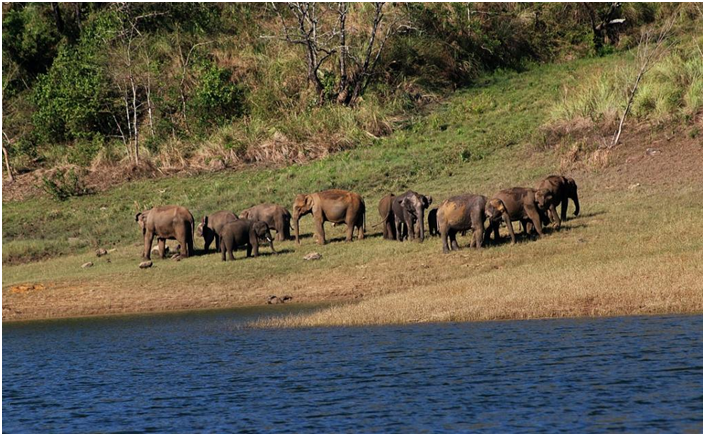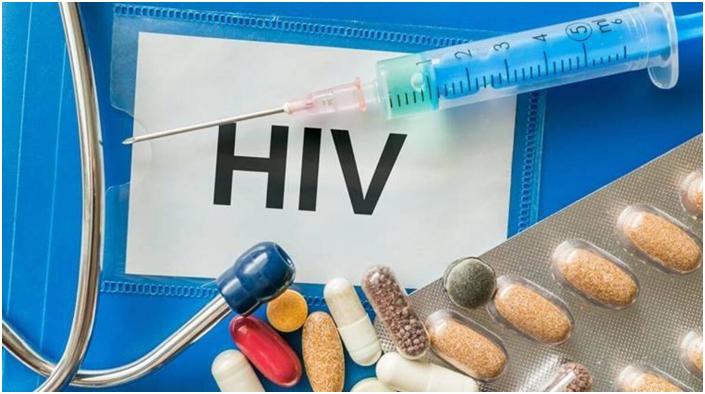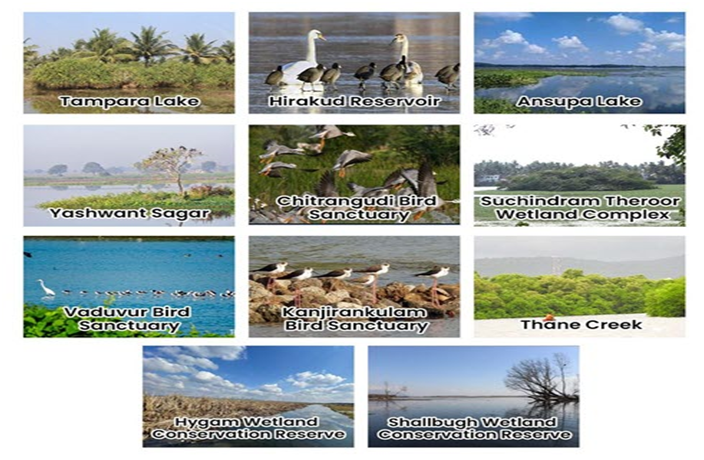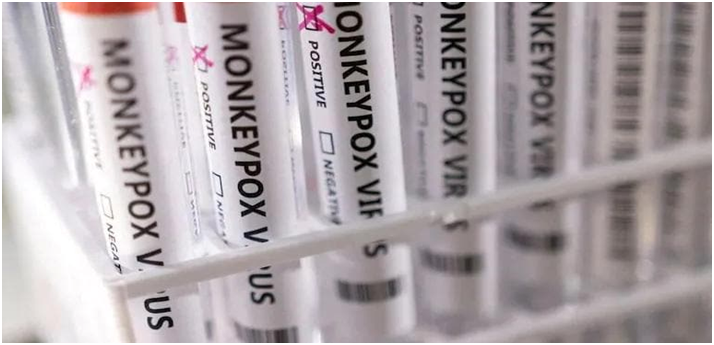Centre notifies India’s 31st elephant reserve in Tamil Nadu (GS Paper 3, Environment)

Why in news?
- Recently, the Union Minister for Environment, Forest and Climate Change announced the notification of one more elephant reserve (ER) in the country in Tamil Nadu during a programme in the Periyar Wildlife Sanctury in Kerala.
Details:
- The new reserve will be spread over an area of 1,197 square kilometres in Agasthiyamalai.
- This will be the 31st ER in the country after Singphan ER in Nagaland was notified in 2018.
Facts about Indian elephant:
- The Indian elephant (Elephasmaximus) is found in the central and southern Western Ghats, North East India, eastern India and northern India and in some parts of southern peninsular India.
- It is included in Schedule I of the Indian Wildlife (Protection) Act, 1972 and in Appendix I of the Convention on International Trade in Endangered Species of Flora and Fauna (CITES).
- The Indian elephant is found in 16 states in the country and is showing an increasing trend across its distributional range.
Census:
- The population of the animals had become critically low in 1992.That is when Project Elephant was launched to ensure the protection of the pachyderms and their environment.
- According to the latest elephant census conducted in 2017, the population of elephants in India has reached up to about 27,312. However, the minister in his address said the population of elephants was near 30,000, with about 29,900 individuals.
- According to the 2017 census, Karnataka had the highest number of elephants (6,049), followed by Assam (5,719) and Kerala (3,054).
HIV drugs shortage is a challenge to ending AIDS in India
(GS Paper 3, Science and Tech)
Context:
- In June, PLHIV (People Living with HIV) networks across the country started witnessing an acute shortage of certain Antiretroviral (ARV) drugs in Anti-Retroviral Therapy (ART) centres. Among them were pediatric formulations and dolutegravir, the backbone of HIV treatment.
- The PLHIV have been protesting peacefully for the past 23 days continuously on the premises of the National AIDS Control Organisation (NACO).
- It is calling attention to the need for emergency procurement of ARVs and the unintended consequences of a weak and ineffective supply chain.

Why antiretroviral therapy need to be consistent?
- People living with HIV need access to treatment with a combination of drugs known as antiretroviral therapy to suppress the virus, preserve their health, and prevent transmission of the virus to an HIV-negative partner. Staying on anti-retroviral therapy continuously is crucial to keep the virus suppressed.
- But the virus can mutate into a resistant form if treatment delivery is poor or patchy.
- Governments such as the Indian government have made considerable advances in providing access to testing and antiretroviral therapy (ART) for people living with HIV.
- While there has been a reduction in AIDS-related deaths since 2004, progress has stalled in recent years, highlighting the need to address health system challenges such as disruptions in the medicine supply chain to end AIDS.
Bureaucratic delays:
- The National AIDS Control Organisation (NACO) under the Ministry of Health and Family Welfare is the nodal agency responsible for overlooking and coordinating activities of the National AIDS Control Programme (NACP) along with the Central Medical Services Society, which is responsible for centralised tendering and pooled procurement of different HIV products, including Antiretroviral drugs.
- The tender for pooled procurement of life-saving antiretroviral medicines has faced bureaucratic delays in 2014, 2017, and now again in 2022.
Lack of treatment:
- A few days ago, NACO, in its public communication, claimed that 95% of PLHIVs have not faced any shortages. But by its own admission, the current shortages affect 5% of 14.5 lakh people. People living with HIV report that ART centres are struggling to keep them on treatment.
- PLHIVs receive a minimum “one month’s dose” from ART centres. Some have had their regimen changed due to the unavailability of certain ARVs and are worried if these changes are based on the World Health Organization’s guidelines and compromise their future treatment options.
- Shortages of health products in the supply chain of health programmes are not India’s problem alone and are commonly experienced in low- and middle-income settings. However, India has IT-enabled and community monitoring tools at its disposal.
Way Forward:
- What is urgently needed is the political will from the Ministry of Health to take necessary measures to ensure that drug shortages, as happened over the last decade, are not experienced by its programmes, such as HIV and TB, in the future.
- If ignored, the consequences impact the right to health and drive drug resistance, a significant public health challenge for the country.
Ramsar tag for 75 Indian wetlands on 75th year of Independence
(GS Paper 3, Environment)
Why in news?
- Recently, as per the Union Environment Ministry, eleven Indian sites have been added to the Ramsar list, taking the number of wetlands of international importance in the country to 75 in the 75th year of Independence.

What is Ramsar List?
- The Ramsar list aims at ”developing and maintaining an international network of wetlands which are important for the conservation of global biological diversity and for sustaining human life through the maintenance of their ecosystem components, processes and benefits”.
- The Ramsar convention, which was initiated in the year 1971, is an intergovernmental treaty for the conservation and sustainable use of Ramsar sites.
- The convention of wetlands is named after the city of Ramsar in Iran where it was first signed. India has the highest number of Ramsar sites among the South Asian nations.
- The list begins with the inclusion of Chilikalake and Keoladeo National Park, the first Ramsar-recognised sites in the country.
- India is one of the contracting parties to the Ramsar Convention, signed in Ramsar, Iran, in 1971. New Delhi signed it on February 1, 1982.
Key Highlights:
- Of the 11 sites, four are in Tamil Nadu, three in Odisha, two in Jammu and Kashmir and one each in Madhya Pradesh and Maharashtra.
- Twenty-eight Indian sites have been declared wetlands of international importance this year itself.
- A total of 26 sites were added to the Ramsar list from 1982 to 2013. Since 2014, 49 sites have bagged the coveted tag.
New Indian wetlands of international importance:
Tamil Nadu:
- Chitrangudi Bird Sanctuary
- SuchindramTheroor Wetland Complex
- Vaduvur Bird Sanctuary
- Kanjirankulam Bird Sanctuary
Odisha:
- Tampara Lake
- Hirakud Reservoir
- Ansupa Lake
Jammu and Kashmir:
- Hygam Wetland Conservation Reserve
- Shallbugh Wetland Conservation Reserve
Maharashtra:
Madhya Pradesh:
Way Forward
- Tamil Nadu has the maximum number of Ramsar sites (14), followed by Uttar Pradesh (10).
- The 75 Ramsar sites in the country cover an area of 13,26,677 hectares.
- The designation of these sites would help in conservation and management of wetlands and wise use of their resources.
WHO announces new names for monkeypox virus variants using Roman numerals
(GS Paper 3, Science and Tech)
Why in news?
- Recently, a group of global experts convened by the World Health Organisation (WHO) agreed on new names for monkeypox virus variants, as part of ongoing efforts to align the names of the monkeypox disease, virus and variants with current best practices.
- The experts agreed to name the clades using Roman numerals.

Background:
- The monkeypox virus was named upon first discovery in 1958 before current best practices in naming diseases and viruses were adopted.
- Major variants were identified by the geographic regions where they were known to circulate.
What is the Current best practice followed?
- Current best practise is that newly-identified viruses, related diseases, and virus variants should be given names with the aim to avoid causing offense to any cultural, social, national, regional, professional, or ethnic groups, and to minimize any negative impact on trade, travel, tourism or animal welfare.
- Experts in pox virology, evolutionary biology and representatives of research institutes from across the globe reviewed the phylogeny and nomenclature of known and new monkeypox virus variants or clades.
- They discussed the characteristics and evolution of monkeypox virus variants, their apparent phylogenetic and clinical differences, and potential consequences for public health and future virological and evolutionary research.
Clade:
- The group reached a consensus on a new nomenclature for the virus clades that is in line with best practices. They agreed on how the virus clades should be recorded and classified on genome sequence repository sites.
- The consensus was reached to now refer to the former Congo Basin (Central African) clade as Clade one (I) and the former West African clade as Clade two (II).
Thus, the new naming convention comprises Clade I, Clade IIa, and Clade IIb, with the latter referring primarily to the group of variants mainly circulating in the 2022 global outbreak.
What’s next?
- The naming of lineages will be proposed by scientists as the outbreak evolves. Experts will be reconvened as needed.
- The new names for the clades will come into effect immediately while work continues on the disease and virus names.





